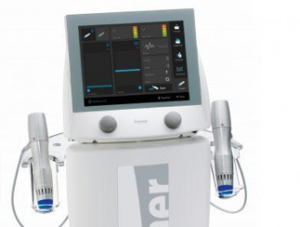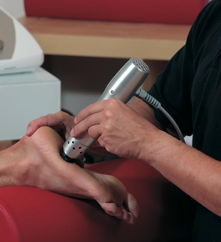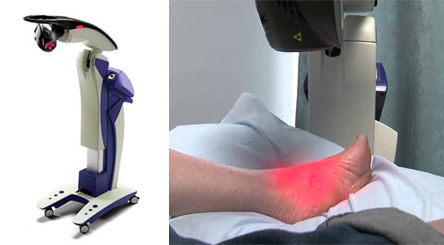Roy A. Rothman, DPM, PA
Podiatric Medicine and SurgeonFoot & Ankle Specialist

The Importance of Identifying the Reason for Your Heel Pain
Heel pain can be difficult to deal with, especially if you do not know what the underlying cause is. If you ignore your heel pain, the pain can magnify and potentially develop into a chronic condition. Depending on the location of your heel pain, you have developed a specific condition.
Plantar Fasciitis
One condition is plantar fasciitis. Plantar fasciitis is caused by the inflammation of the plantar fascia, or the band of tissue that connects the heel bone to the base of the toes. The pain from this condition is initially mild but can intensify as more steps are taken when you wake up in the morning. To treat this condition, medication will likely be necessary. Plantar fasciitis is often associated with heel spurs; both require rest and special stretching exercises.
Treatment Options
There are various options your podiatrist may suggest for heel pain. Treatment options for heel pain typically include non-steroidal anti-inflammatory drugs (NSAIDS), which may reduce swelling and pain. Other options are physical therapy, athletic taping, and orthotics. In severe cases of heel pain, surgery may be required.
Preventative Measures
Preventing heel pain is possible. If you are looking to prevent heel pain from developing in the future, be sure to wear shoes that fit you properly and do not have worn down heels or soles. Be sure to warm up properly before participating in strenuous activities or sports that place a lot of a stress on the heels. If you are experiencing any form of heel pain, speak with your podiatrist to determine the underlying cause and receive the treatment you need.
What is Radial Shockwave Therapy?

Radial Pulse Shockwave Therapy is an FDA cleared technology proven to increase the rate of healing for soft tissue tendinopathy. It is the most advanced non-invasive and highly effective treatment method that enhances blood circulation and accelerates the healing process causing damaged tissue to gradually regenerate.
What conditions can be treated with RSWT?
How does RSWT work?
When you experience chronic pain, your body no longer recognizes that there is an injury to that area. As a result, it shuts down the healing process and you feel no relief. The ballistic sound waves of the Enpuls penetrate deep through your soft tissue, causing a microtrauma or new inflammatory condition to the treated area. Once this occurs, it then triggers your body’s natural healing response once again. The energy emitted also causes the cells in the soft tissue to release certain bio-chemicals that intensify the body’s natural healing process. These bio-chemicals allow for the building of an array of new microscopic blood vessels in the soft tissue.
What do studies show?
There have been extensive studies done on Low Energy Shockwave Therapy over the past 20 years. These studies show between a 72% – 80% success rate.
How is RSWT performed?

The system is a machine with an applicator that looks like an ultrasound. It is administered once a week for a series of 4 to 5 treatments. Each treatment takes approximately 5 minutes depending on the size and number of areas treated.
All treatments are performed by experienced professionals. The Doctor applies the applicator to the area and administers the ballistic waves by moving over the affected area in a very slow, circular motion. During the treatment, there may be some minor discomfort. Painful areas are helpful in isolating the truly injured areas.
Why consider Radial Shockwave Therapy?
RSWT has a proven success rate that is equal to or greater than that of traditional treatment methods, including surgery, without the risks, complications, and lengthy recovery periods. There are no incisions and no risk of infection, or scar tissue, like with surgery.
There is no need for anesthesia to be administered during the treatment, as opposed to high-energy shockwave therapy. Patients treated with RSWT may be active immediately and resume their normal routine the same day. Many patients find a significant and immediate reduction in their pain. Some patients will feel results gradually after each treatment.
Why RSWT instead of Physical Therapy?
Physical therapy is 2 to 3 times a week, for 6 weeks and you are at the facility for no less than an hour. More importantly, there is usually a co-pay required for every visit which could be $40 or more. Over a six week period or 15 visits, this can add up to $600 in out of pocket co-pays.
The RSWT treatments are only once a week, for 5 minutes each. This is a highly effective modality which is faster and more effective than Physical therapy, and the cost of the RSWT treatments are usually LESS than the total of your PT co-pays. If you want fast results in less time, and would like to save money, the RSWT treatment is a better choice.
What are the possible side effects?
There have been very few side effects reported. In rare cases, skin bruising may occur. Patients may also feel soreness in the area for a day or two afterward, similar to a strenuous workout.
Will I be in pain afterward?
A day or two after the treatment you may feel a slight discomfort like a bruise, but that is normal and is a sign the treatment is working.
Is it covered by my Insurance?
No. RSWT is not covered by insurance plans, but ask your Doctor how they can make it affordable for you.
 MLS Laser Therapy is being cited as the wave of the future in pain management amongst podiatrists for its ability to quickly return patients to their everyday activities. We are proud to be on the medical technological forefront by offering MLS Laser Therapy. In our quest to deliver the best in foot and ankle care, our practice has invested in the very best technology as an important component. MLS Laser Therapy is FDA-approved and has been proven successful as shown by extensive studies conducted in many of our country’s top institutions. Manage pain, reduce inflammation, and enjoy a speedy recovery with MLS Laser Therapy.
MLS Laser Therapy is being cited as the wave of the future in pain management amongst podiatrists for its ability to quickly return patients to their everyday activities. We are proud to be on the medical technological forefront by offering MLS Laser Therapy. In our quest to deliver the best in foot and ankle care, our practice has invested in the very best technology as an important component. MLS Laser Therapy is FDA-approved and has been proven successful as shown by extensive studies conducted in many of our country’s top institutions. Manage pain, reduce inflammation, and enjoy a speedy recovery with MLS Laser Therapy.
What is Laser Therapy?
Laser Therapy is the use of certain wavelengths of light to treat various painful and debilitating conditions.
How does it work?
Light energy enters the damaged cells and stimulates inter-cellular activity. This causes the reduction of pain in the area and an increased rate of recovery in the damaged cells. Upon the completion of the cells’ recovery, the healing process is complete.
What can I expect during a treatment?
MLS Laser Therapy is a painless treatment that lasts an average of 8 minutes. A comfortable sensation may be felt at the point of application.
MLS Laser Therapy effectively treats:
Benefits of MLS Laser Therapy